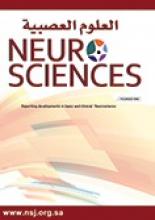Abstract
OBJECTIVE: To study the pattern of migraine, and to show the effect of age and duration of illness on the evolution of migraine symptoms.
METHODS: A review of 200 migraine cases (attending the outpatient neurology clinic at Rezgary Teaching Hospital, and Kurdistan Private Neurology Clinic) was carried out during the period between October 2007 to May 2008. Case definition of migraine was according to the International Headache Society (IHS) criteria.
RESULTS: The majority (77%) of the studied sample was female. The mean age (+/- SD) at onset was 22.33+/-9.52 years. The most common type of migraine observed was migraine without aura (72%). Different symptoms like phonophobia (92%), nausea (86.5%), photophobia (84%), vertigo (78%), scalp tenderness (75%), attacks of facial pallor (64%), sweating (57%), vomiting (50%), pain in the arms (39%), and pain in the chest (6%) was studied in relation to age at presentation and duration of illness in years. No significant association was found between the duration of illness and age at presentation and evolution of migraine symptoms. No significant association was found between the duration of illness and frequency of the attacks.
CONCLUSION: Many migraine symptoms remain the same in each attack no matter the duration of illness and age at presentation, except for bouts of vomiting, which may be less common in younger patients.
- Copyright: © Neurosciences
Neurosciences is an Open Access journal and articles published are distributed under the terms of the Creative Commons Attribution-NonCommercial License (CC BY-NC). Readers may copy, distribute, and display the work for non-commercial purposes with the proper citation of the original work.






